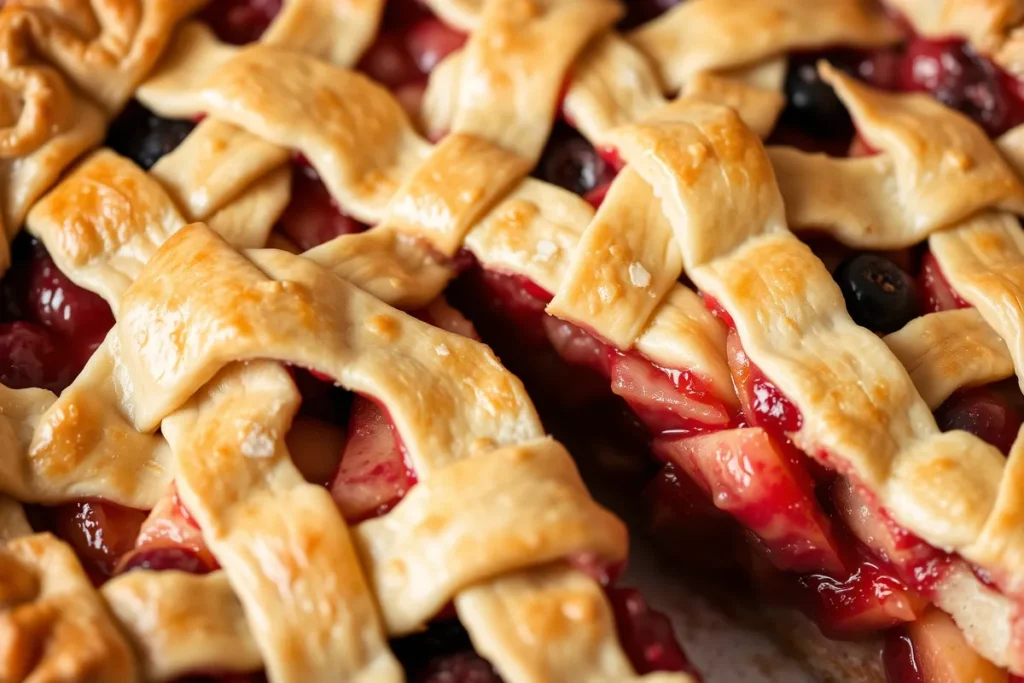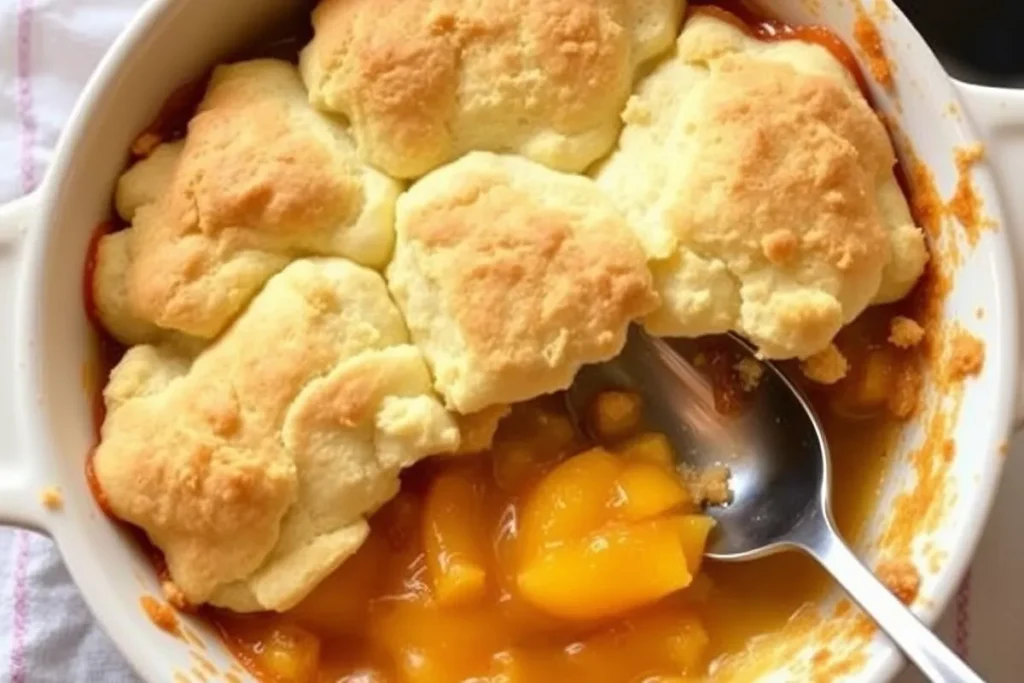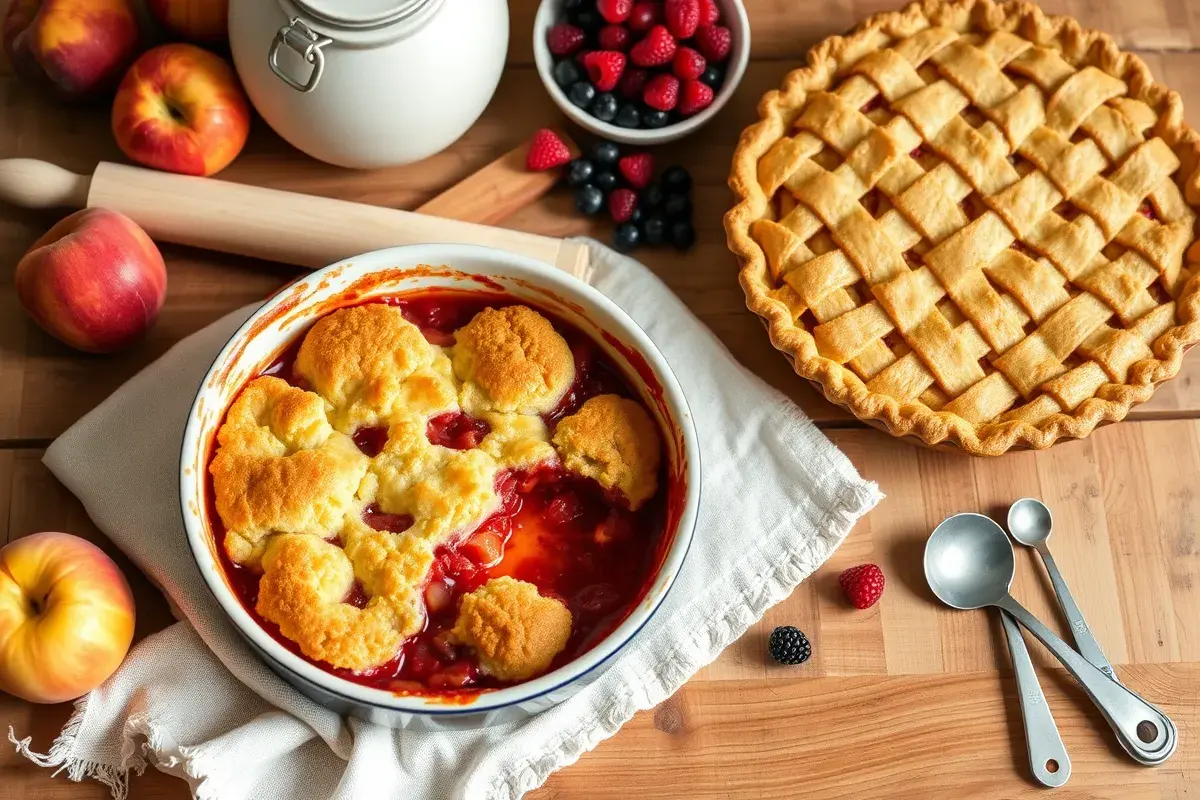Fruit desserts hold a special place in culinary history. They’re sweet, comforting, and perfect for gatherings or quiet evenings at home. However, what makes a cobbler different from a pie? Many people assume they’re the same, merely because both desserts often contain fruit fillings under some form of crust. Yet, the differences are surprisingly significant.
Pies typically have a carefully rolled crust and, depending on the type, sometimes a top crust or a lattice design. Cobblers, on the other hand, rely on a simple, biscuit-like topping that sets them apart. Understanding how these two desserts differ can help you choose which one best suits your taste buds. Therefore, by the end of this article, you’ll not only know the distinctions between cobblers and pies but also feel equipped to select—or even bake—the perfect dessert for any occasion.
In this comprehensive guide, we’ll delve into everything from the historical origins of these dishes to their respective fillings, toppings, and serving methods. We’ll also explore regional variations, health considerations, and tips for making your desserts shine. Most importantly, we’ll thoroughly answer the question: What makes a cobbler different from a pie? Let’s begin.
Why People Love Fruit Desserts
Fruit desserts captivate the senses like no other sweet treat. They combine natural fruit flavors with comforting pastry or dough. Moreover, they’re versatile: you can serve them hot or cold, plain or topped with ice cream, and on weekdays or special occasions.
- Flavor Variety: Apples, peaches, berries, and even savory fruit options create many taste experiences.
- Satisfying Textures: Crisp crusts, crumbly toppings, and thick fillings complement each other in delightful ways.
- Seasonal Appeal: Fresh fruit often aligns with specific times of the year, making each dessert feel timely.
Desserts like cobblers and pies have become mainstays in many cultures. In fact, they’ve evolved through the ages. Early European settlers introduced pies and cobblers to North America using local ingredients. However, the two desserts quickly took on their own identities. Therefore, figuring out what makes a cobbler different from a pie is essential for anyone who takes their fruit-filled sweets seriously.
Early History of Fruit Desserts
Dating back centuries, pies once served as practical ways to preserve meats and fruits for long voyages. For example, the crust acted as a storage vessel, safeguarding fillings from the environment. Over time, cooks realized how tasty the crust could be when prepared with butter, lard, or other fats. Hence, what started as a storage method became a culinary art form.
Cobblers, on the other hand, gained popularity as a more rustic dish. Settlers, short on resources and time, made a quick dough that was dropped over fruit and then baked to perfection. This technique was less intricate than rolling out a pie crust. Nevertheless, it yielded a hearty treat that satisfied those craving a sweet finish to their meals.
Classic Pie Components

To truly understand what makes a cobbler different from a pie, we must break down the components of a traditional pie. Although there are countless variations, most pies have three main elements:
- Crust or Pastry Shell
A good crust is often described as flaky, tender, or buttery. Pie crusts typically require rolling out dough made with flour, a type of fat (often butter), salt, and cold water. - Filling
Fillings can be sweet (fruit, custard, cream) or savory (meat, vegetables). Fruit pies, specifically, often balance sugar, spices (like cinnamon or nutmeg), and a thickening agent (such as cornstarch or tapioca) to achieve the right consistency. - Optional Top Layer
Some pies feature lattice or solid top crusts, which seal in moisture and create a visual appeal. Alternatively, single-crust pies reveal their filling from the top.
Types of Pies
- Single-Crust Pie: Has only a bottom crust, leaving the filling exposed on top.
- Double-Crust Pie: Includes both a bottom crust and a top crust or lattice.
- Galette: A free-form pie, often folded around the filling without a dedicated pie dish.
The pastry’s thickness and presentation vary. Nevertheless, the hallmark of pies is the rolled crust that encases or partially covers the filling. Indeed, this emphasis on crust preparation distinguishes a pie from its simpler cousin, the cobbler.
The Art of Pie Making
Pie-making can be somewhat labor-intensive. Rolling out dough to the correct thickness and shape demands patience and practice. However, success yields a light, flaky crust that pairs beautifully with the sweet, saucy filling within. Many bakers enjoy the artistic element of designing a lattice or decorative edges. Therefore, pie-making is a mix of precision, art, and a little bit of science.
Key Elements of a Cobbler

Now that we’ve covered the basics of pies, it’s time to focus on cobblers. What makes a cobbler different from a pie? Let’s explore the essential components and preparation methods that define this rustic dessert.
- Fruit Filling
Like pies, cobblers typically showcase fruit. However, the fruit often remains chunkier in a cobbler, lending more texture to each bite. No rolling or molding of dough is required around this filling. - Topping
Cobblers use a biscuit-like dough or sometimes cake batter as a topping. This topping gets dropped or spooned over the fruit in small mounds, creating a “cobbled” appearance—hence the name cobbler. - Baking Dish
Cobblers are usually baked in deep-dish pans or casserole dishes. The topping covers the fruit but does not envelop it as a pie crust would.
Cobbler Variations
- Biscuit-Style Cobbler: A classic approach using a buttermilk or cream-based biscuit dough.
- Cake-Style Cobbler: Popular in some regions, this version includes a thicker, more cake-like batter.
- Crisp and Crumble Relatives: Crisp and crumble are often confused with cobbler, though they use streusel-like toppings rather than biscuits or batter.
Many people find cobblers easier to prepare than pies. The topping requires less finesse than pie dough. Consequently, making a cobbler can be an ideal entry point for beginner bakers.
Texture and Taste
In a cobbler, the fruit is partially submerged under a soft, bread-like topping. When baked, the topping becomes golden and crusty on the surface while remaining moist inside. Consequently, each spoonful merges tangy, sweet fruit juices with fluffy biscuits (or cake). This combination leads to a warm, comforting dessert that pairs well with ice cream or whipped cream.
What Makes a Cobbler Different From a Pie? A Closer Look
We’ve introduced general aspects of both desserts. Now, let’s pinpoint what makes a cobbler different from a pie at a deeper level. Several factors come into play, especially the topping, crust treatment, presentation, and overall ease of preparation.
- Crust vs. Biscuit Topping
- Pie: Relies on a rolled, often flaky crust made from a dough of flour, butter or lard, and water. This crust covers the bottom of a dish, and sometimes the top as well.
- Cobbler: Requires a biscuit or cake-like batter dropped on top of fruit. There’s no bottom crust to hold the filling.
- Filling Consistency
- Pie: Tends to have a well-thickened filling that slices cleanly once cooled.
- Cobbler: Serves up a looser filling. The juices from the fruit often bubble up around the topping.
- Skill and Time
- Pie: Rolling dough and achieving a good crust texture can be challenging and time-consuming.
- Cobbler: The topping is quick to whip up. Therefore, the entire process tends to be more relaxed.
- Serving Method
- Pie: Typically served in slices, revealing a neat wedge of crust and filling.
- Cobbler: Scooped directly from the baking dish in portions.
Because of these key differences, home cooks often choose between cobbler and pie based on the time they have and the texture they prefer. In addition, regional traditions also influence which dessert appears on the dinner table.
Historical and Regional Roots
Understanding what makes a cobbler different from a pie also involves recognizing their historical paths. Both desserts boast long histories, tracing their beginnings to European cuisine. However, they’ve evolved differently in various parts of the world.
Pies: A Global Phenomenon
Pies took root in Europe as both savory and sweet dishes. When European settlers crossed oceans, they brought pie-making techniques with them. Apple pies, peach pies, and berry pies became integral to North American comfort food. For example, the phrase “as American as apple pie” underscores how deeply pies are woven into United States culture.
Cobblers: Rustic American Heritage
Cobblers emerged as a simpler alternative when colonists lacked traditional ingredients or proper kitchens. Instead of rolling dough, pioneers spooned biscuit batter over fruit. Over time, this method gained widespread acceptance, particularly in the American South. Peach cobbler remains a beloved classic at Southern gatherings, symbolizing homestyle cooking at its best.
Regional Variations of Cobblers
- Grunt or Slump (New England): Fruit cooked on the stovetop with biscuit dough on top, so the dough steams.
- Pandowdy (Pennsylvania Dutch): A dish similar to a cobbler with a crust that is sometimes broken up and mixed back into the fruit.
- Sonker (North Carolina): A deep-dish dessert, often with a lattice or pastry top resembling a hybrid of pie and cobbler.
Each area modifies the ingredients or cooking method to suit its local culture. Nevertheless, the basic concept—a hearty fruit dessert with a biscuit-like topping—remains consistent.
Flavor Profiles and Ingredient Possibilities
Both cobblers and pies feature a wide array of fruit fillings. Therefore, it can be challenging to decide which dessert to make. Below are common fruits and additional flavor enhancers that suit these desserts well.
Fruit Fillings
- Apples: Ideal for pies, with varieties like Granny Smith or Honeycrisp providing tartness. Apple cobblers also deliver sweet-tart magic.
- Peaches: A cobbler classic, though peach pies are also popular.
- Berries: Mixed berry or single-variety options (blueberry, strawberry, raspberry) create vibrant summer desserts.
- Cherries: Cherry pie is iconic, but cherry cobbler offers a more rustic appeal.
- Tropical Fruits: Mango or pineapple can add an exotic twist.
Enhancing Flavors
- Citrus Zest (Lemon, Orange): Lifts the sweetness of fruit fillings.
- Warm Spices (Cinnamon, Nutmeg, Cardamom): Provide depth and warmth.
- Vanilla or Almond Extract: Adds aromatic sweetness.
- Herbs (Basil, Rosemary): Offer intriguing flavor profiles when used sparingly.
Whether you’re making a pie or cobbler, experimenting with flavors can make the dessert unforgettable. However, the texture differences between the two remain the true answer to what makes a cobbler different from a pie.
What Makes a Cobbler Different From a Pie? Regional Variations
Although both desserts can include similar fruits, local traditions significantly influence preparation and presentation. Hence, regions famous for a specific fruit often develop unique cobbler or pie recipes.
Southern-Style Peach Cobbler vs. Traditional Peach Pie
- Southern-Style Peach Cobbler: Often made with fresh peaches, sugar, and a touch of spice, topped with a sweet biscuit dough. It’s served piping hot, usually with a scoop of vanilla ice cream.
- Traditional Peach Pie: Uses a rolled crust that encloses sweet, spiced peaches. Slices hold their shape nicely after cooling.
In the South, peach cobbler becomes a staple at barbecues and Sunday dinners. Meanwhile, Northern regions, known for orchard-grown apples, often favor apple pie, referencing their storied apple harvests.
Berry Pies vs. Berry Cobblers
- Berry Pie: The fruit rests in a thickened filling, often stabilized with cornstarch.
- Berry Cobbler: The fruit remains juicy, with a biscuit topping absorbing some of the berry juices as it bakes.
Both are delightful, yet their textures differ. The cobbler’s top soaks in sweet fruit syrup, creating a soft underside with a crispy surface. Pie crust, conversely, is flakier, providing a more rigid structure around the fruit.
Health Considerations
Desserts might not be the most health-conscious foods, but you can still make informed choices. In terms of what makes a cobbler different from a pie nutritionally, several factors come into play:
- Caloric Content
- Pie: The crust adds calories. Double-crust pies contain more fat and calories than single-crust pies.
- Cobbler: Biscuits or batter can also be high in calories, but you can reduce fat by using low-fat milk or cutting back on sugar.
- Fruit to Dough Ratio
- Pie: Often has a high ratio of crust to fruit.
- Cobbler: Generally features more fruit compared to the portion of topping.
- Customization
- Pie: Adjust sweetness and crust thickness to reduce calorie intake.
- Cobbler: Swap out butter for healthier fats or use whole-grain flours in the biscuit topping.
Therefore, both desserts can be enjoyed responsibly with minor adjustments. Moreover, focusing on fresh, ripe fruit can reduce the need for excessive sugar.
Tips for Making the Perfect Cobbler or Pie
Knowing what makes a cobbler different from a pie is only the first step. The following tips can help you elevate your baking game, regardless of which dessert you choose:
- Choose Quality Ingredients
Use fresh, ripe fruit whenever possible. Good fruit will enhance both flavor and texture. - Control the Juiciness
- Pie: Thicken the filling properly to prevent a soggy crust. Cornstarch or flour can help.
- Cobbler: Expect juices to bubble up around the topping. Consider a thicker fruit mixture if you prefer less liquid.
- Pay Attention to Temperature
- Pie Dough: Keep your ingredients cold. This tactic yields a flakier crust.
- Cobbler Dough: Don’t overmix; a few lumps create a tender biscuit.
- Proper Baking Time
- Pie: Check for a golden-brown crust and bubbling filling around the edges.
- Cobbler: Ensure the biscuit topping is fully cooked in the middle.
- Serve at the Right Temperature
- Pie: Let it cool enough to set the filling before cutting.
- Cobbler: Serve warm, often straight out of the oven.
Step-by-Step Recipe: Making a Classic Peach Cobbler
Below is a simple guide if you want to explore what makes a cobbler different from a pie through hands-on experience. This easy peach cobbler recipe offers a delightful introduction to cobbler-making.
- Gather Your Ingredients
- 2 pounds of fresh peaches, sliced
- ½ cup sugar (adjust to taste)
- 1 tablespoon cornstarch
- 1 teaspoon lemon juice
- 1 cup all-purpose flour
- 2 tablespoons sugar (for the topping)
- 1½ teaspoons baking powder
- ¼ teaspoon salt
- ¾ cup milk
- 4 tablespoons unsalted butter, melted
- Prepare the Filling
- In a baking dish, toss peach slices with sugar, cornstarch, and lemon juice.
- Spread evenly in the bottom of the dish.
- Make the Topping
- In a bowl, combine flour, sugar, baking powder, and salt.
- Stir in milk and melted butter, mixing until just combined.
- Assemble
- Drop spoonfuls of batter over the peaches. The batter should create uneven mounds resembling cobblestones.
- Bake
- Place the dish in a preheated oven at 375°F (190°C).
- Bake for about 30–35 minutes, or until the topping is golden brown and the fruit is bubbly.
- Serve
- Let it cool for a few minutes, then serve warm. A scoop of vanilla ice cream elevates the experience.
Unlike a pie, this cobbler doesn’t have a bottom crust. Instead, the biscuit-like topping highlights the fruit’s natural sweetness, providing a comforting and rustic dessert.
Serving Suggestions and Pairings
Desserts like cobblers and pies often become centerpieces at family dinners. However, their presentation can differ. For instance, a pie slice stands on its own plate, sometimes accompanied by whipped cream or a dollop of ice cream. A cobbler, on the other hand, is often scooped from a baking dish into a bowl, allowing the fruit and topping to mingle freely.
Popular Accompaniments
- Ice Cream: Vanilla, caramel, or butter pecan can enhance the dessert’s creaminess.
- Whipped Cream: Light and airy, perfect for topping fruit-heavy bites.
- Custard Sauce: Poured warm over slices of pie or spoonfuls of cobbler, adding a luxurious twist.
- Cheddar Cheese: Some regions serve apple pie with a slice of cheddar, introducing a salty-sweet flavor contrast.
Although pies often get more decorative attention, don’t underestimate the visual charm of a golden-brown cobbler topping bubbling around fresh fruit. Indeed, some consider this look more inviting than a meticulously arranged pie crust.
Storage and Leftovers
Proper storage can maintain the quality of your dessert. Generally, fruit pies and cobblers keep well for two to three days at room temperature if covered. If you have leftover pie or cobbler:
- Refrigeration: Store them in airtight containers or cover with plastic wrap.
- Reheating: Gently warm slices of pie in the oven. For cobblers, reheat in the oven at 350°F (175°C) until the topping is crisp again.
- Freezing: You can freeze both pies and cobblers, although the textures might shift slightly upon thawing.
Therefore, plan your portions based on when and how you’ll serve the dessert. If you expect guests to devour it immediately, consider making a larger dish. Otherwise, store leftovers properly for continued enjoyment.
What Makes a Cobbler Different From a Pie? Final Thoughts
At this point, you should have a clearer picture of what makes a cobbler different from a pie. From crust construction to serving methods, these desserts bring distinct experiences to the table. Pies, with their flaky crusts and structured slices, can be both elegant and comforting. Cobblers, rustic and fuss-free, offer a homier experience with biscuit-topped fruit that melts in your mouth.
Whether you’re a pie enthusiast or a cobbler devotee, both desserts deserve a spot in your recipe collection. Experiment with different fruits, sweeteners, and spices to find your perfect balance. Above all, enjoy the baking process—these desserts are meant to bring joy, comfort, and a sweet finale to any meal.
Frequently Asked Questions (FAQ)
1. Can I use frozen fruit for both pies and cobblers?
Yes. Frozen fruit works well in both pies and cobblers. However, you might need to adjust the thickening agent. Frozen fruit releases more liquid than fresh fruit. Therefore, add extra cornstarch or flour to compensate for the excess moisture.
2. How can I prevent a soggy pie crust?
To avoid a soggy bottom crust, blind-bake it before adding the filling. Blind-baking involves baking the crust on its own (often with pie weights) for a short time. This step ensures the crust sets and helps it resist the moisture from the filling.
3. Is it possible to make a gluten-free cobbler?
Absolutely. Several gluten-free flours (like almond flour or a gluten-free all-purpose blend) can substitute for wheat flour. You may need to adjust the liquid ratio, but the result can be just as delicious.
4. Why does my fruit pie sometimes overflow?
When fruit pies bake, the filling expands and releases steam. If you fill the pie dish too much or the crust is sealed tightly, the steam can’t escape. Therefore, it seeps out around the edges or through vents, sometimes causing an overflow. Cutting vents in the top crust or leaving headspace can help.
5. Which dessert is easier for beginners to make, pie or cobbler?
Most beginners find cobblers easier to make. The biscuit or batter topping requires less precision than rolling out a pie crust. For example, if you’re intimidated by the intricate process of pie dough, try a cobbler first.
6. Can I use the same filling recipe for both desserts?
In many cases, yes. Just keep in mind that a pie filling needs to be thick enough to slice, while a cobbler filling can be a bit looser. Adjust thickening agents accordingly.
7. Do I need any special equipment to bake a cobbler?
Not typically. While pies require a pie dish, cobblers can be made in any deep baking dish or casserole. A standard baking pan works fine, making cobblers more accessible for those without special pans.
8. Are there vegan options for pie and cobbler crusts?
Yes. You can replace butter with vegan butter or coconut oil. In addition, plant-based milk works in cobbler toppings. Always check that other ingredients, such as sweeteners, align with your dietary needs.
9. What sides or toppings pair best with peach cobbler?
Vanilla ice cream is a classic choice. Whipped cream also works well. For a more decadent twist, drizzle caramel sauce or pair it with toasted pecans.
10. Can I make a savory cobbler?
Certainly. You can create a savory cobbler using ingredients like chicken, vegetables, and a biscuit topping. Think of it as a simpler version of pot pie, minus the bottom crust.
May your baking adventures be sweet, delicious, and satisfying as you explore the nuanced world of pies and cobblers.

